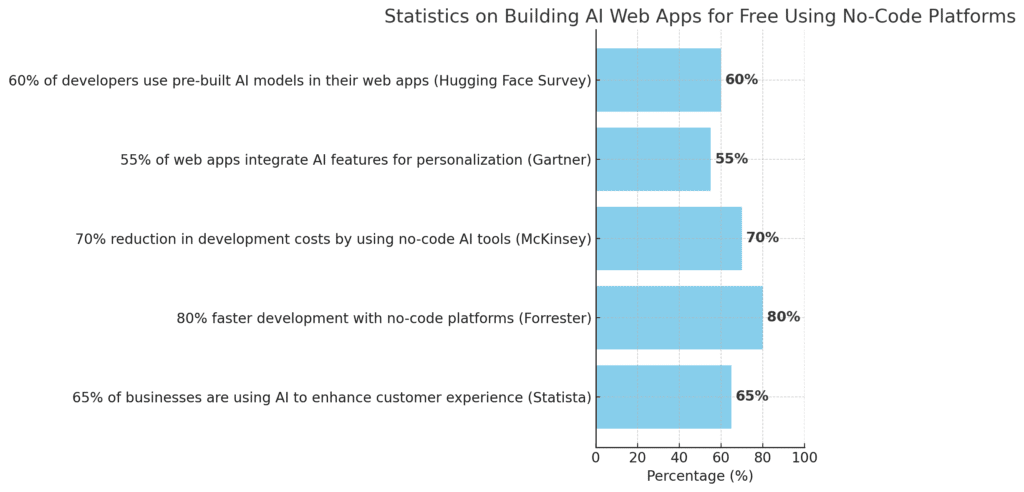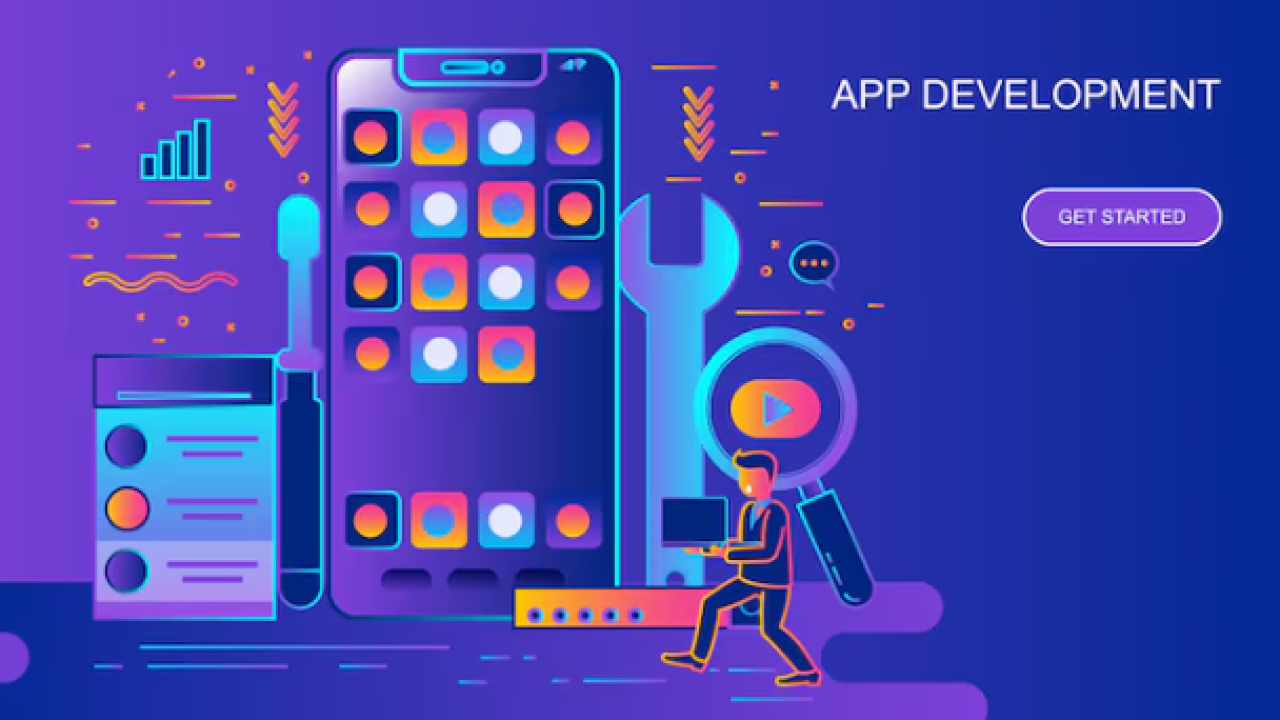Introduction: Unlock the Power of AI in Web Apps

The web development landscape has dramatically evolved, thanks to the integration of Artificial Intelligence (AI) into everyday applications. From personalized recommendations to intelligent chatbots, AI is revolutionizing how web applications serve users. Whether you’re a small business owner, a startup founder, or an aspiring developer, building AI-powered web apps no longer requires deep technical expertise. Thanks to free no-code platforms and AI tools, anyone can create a web app that incorporates powerful AI features.
In this blog, we’ll explore how to build a web app with AI for free, without needing to write any code. We will take you through the process of choosing the right platform, selecting AI features, and deploying your web app, all at zero cost.
Launch Your App Today
Ready to launch? Skip the tech stress. Describe, Build, Launch in three simple steps.
BuildWhy Build a Web App with AI?
Building a web app with AI opens the door to many possibilities. Here are just a few reasons why integrating AI into your web app is a game-changer:
- Enhanced User Experience: AI allows for personalization, recommendations, and predictive behavior, which can significantly improve user engagement and satisfaction.
- Automation: AI can help automate repetitive tasks, such as customer service with chatbots, freeing up your time and resources.
- Data-Driven Decisions: AI can analyze vast amounts of data in real-time and provide insights, helping businesses make more informed decisions.
- Cost-Efficient: Using free AI tools means you can implement AI into your app without the high cost of hiring developers or purchasing expensive AI services.
Key Steps to Build a Web App with AI for Free

Step 1: Define the Purpose of Your Web App
Before you dive into the development process, you must define the purpose of your AI-powered web app. Common AI features in web apps include:
- Chatbots: For automating customer support or providing personalized assistance.
- Image Recognition: For recognizing objects or faces in uploaded images.
- Recommendation Systems: To suggest products, content, or services to users based on their preferences.
- Sentiment Analysis: To analyze customer feedback or social media posts to determine sentiment (positive, negative, or neutral).
Having a clear idea of the app’s purpose will help you determine the necessary AI features and tools to use.
Step 2: Choose a Free No-Code Platform for Web App Development
There are several free no-code platforms available that allow you to build AI-powered web apps. These platforms provide drag-and-drop interfaces, making it easy to create your app without writing code. Here are a few platforms to consider:
1. Bubble
- Overview: Bubble is a powerful no-code platform that enables users to create fully functional web apps, including AI-powered features, without any coding.
- AI Features: You can integrate AI APIs, like NLP (natural language processing) or image recognition, into your app using Bubble’s plugin system.
- Free Plan: Bubble’s free plan includes most essential features, including database management, user authentication, and access to plugins.
- How to Use: Sign up for Bubble, and use the drag-and-drop interface to create the front-end of your web app. You can integrate AI models by connecting to external APIs or using pre-built plugins.
2. Adalo
- Overview: Adalo is another no-code platform designed to create mobile and web apps. It offers seamless integrations with AI tools, such as voice recognition, image recognition, and chatbots.
- AI Features: You can integrate AI models from services like Google Dialogflow or Hugging Face to create intelligent web apps.
- Free Plan: The free plan offers a robust set of features, including access to basic app-building tools, cloud storage, and app deployment.
- How to Use: Visit Adalo, and create a new project. Use the drag-and-drop interface to design the user interface (UI) and add AI features through integrations.
3. Appgyver
- Overview: Appgyver is a powerful no-code platform for building mobile and web applications with pre-built integrations for AI services.
- AI Features: Appgyver supports third-party integrations, such as natural language processing and machine learning, that can be easily added to your app.
- Free Plan: Appgyver offers a free plan for building and deploying apps without limitations.
- How to Use: Sign up for Appgyver, and start building your web app using the platform’s intuitive visual editor. You can integrate AI functionalities by using REST APIs to connect to external AI services.
Step 3: Choose Free AI Tools for Your Web App
Once you’ve chosen a platform to build your web app, it’s time to add AI capabilities. Here are some free AI tools you can integrate into your web app:
1. Teachable Machine (by Google)
- Overview: Teachable Machine allows you to create machine learning models for image, sound, and pose recognition without needing coding skills. You can export the models and integrate them into your web app.
- Free Access: Completely free for training and exporting models.
- How to Use: Visit Teachable Machine, create and train a model, and export it to integrate into your app on platforms like Bubble or Adalo.
2. Dialogflow (by Google Cloud)
- Overview: Dialogflow is an AI tool that enables you to create conversational interfaces, such as chatbots or virtual assistants. You can integrate Dialogflow into your web app to provide automated customer support.
- Free Access: The free version of Dialogflow offers basic features, such as text-based interactions and integration with various messaging platforms.
- How to Use: Sign up for Dialogflow, create a new agent, define intents, and integrate your chatbot into your web app using the platform’s API.
3. IBM Watson
- Overview: IBM Watson offers a variety of AI tools, including natural language understanding, machine learning, and language translation. You can integrate these features into your web app for intelligent data analysis and customer interactions.
- Free Access: IBM Watson provides free access to many AI models, including sentiment analysis, entity recognition, and speech-to-text.
- How to Use: Sign up for IBM Watson, create an account, and use Watson APIs to integrate AI features into your web app.
Step 4: Design and Build Your Web App
After selecting your AI tools, it’s time to start building the web app. Most no-code platforms provide an easy-to-use drag-and-drop editor that allows you to design your app’s UI. Here’s how to proceed:
- Design the UI: Use the platform’s editor to create the user interface of your web app. Design pages, navigation, and interactive elements such as buttons, text inputs, and forms.
- Add AI Features: Use the platform’s API integration features to link your app with the AI models or tools you’ve selected. For instance, you could add a chatbot or image recognition feature depending on your app’s needs.
- Test Your App: Make sure all AI functionalities are working correctly by running tests. For example, test if the chatbot is answering questions correctly or if the image recognition feature identifies objects properly.
Step 5: Deploy Your Web App
Once your app is built and tested, it’s time to deploy it for the world to see. Most no-code platforms like Bubble, Adalo, and Appgyver offer free deployment options, allowing you to publish your web app without paying extra.
- Connect a Domain (Optional): Many platforms offer the ability to connect a custom domain to your app, though this may require upgrading to a paid plan.
- Publish Your App: Once your app is ready, hit the “publish” button, and your app will be live on the web!
Step 6: Monitor and Improve Your App
After deploying your app, it’s important to monitor its performance and make improvements. Use analytics tools to track user interactions, and gather feedback from users to identify areas for improvement. Most AI-powered features can be enhanced as you collect more data, allowing your app to become smarter over time.
Conclusion: Start Building Your AI-Powered Web App for Free
Thanks to the rise of no-code platforms and free AI tools, creating an intelligent web app is now accessible to anyone, regardless of their technical skills. By using platforms like Bubble, Adalo, and Appgyver, combined with free AI tools like Teachable Machine, Dialogflow, and IBM Watson, you can quickly build a fully functional, AI-powered web app without writing any code and without upgrading to paid plans.
Whether you’re building a chatbot, an image recognition app, or a recommendation engine, the power of AI is now at your fingertips. So why wait? Start building your AI-powered web app today!
FAQs on Building AI Web Apps for Free
1. Do I need coding skills to build an AI web app?
No, no-code platforms are designed for non-technical users, so you don’t need coding skills to create AI-powered web apps.
2. Can I integrate AI features into my app for free?
Yes, there are many free AI tools and platforms available, such as Teachable Machine, Dialogflow, and IBM Watson, that offer free plans to integrate into your web app.
3. How long does it take to build an AI web app?
Building a simple AI web app can take a few hours or days, depending on the complexity of the app and the AI features you’re integrating.
4. Can I deploy my AI web app for free?
Yes, platforms like Bubble, Adalo, and Appgyver offer free deployment options for your web app.
5. Can I upgrade my app later?
Yes, if your app grows and you need more features, you can upgrade to a paid plan for additional resources and capabilities.
Launch Your App Today
Ready to launch? Skip the tech stress. Describe, Build, Launch in three simple steps.
Build




